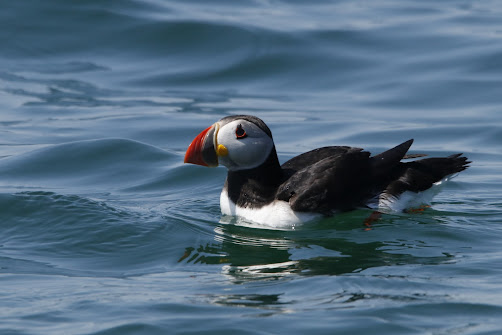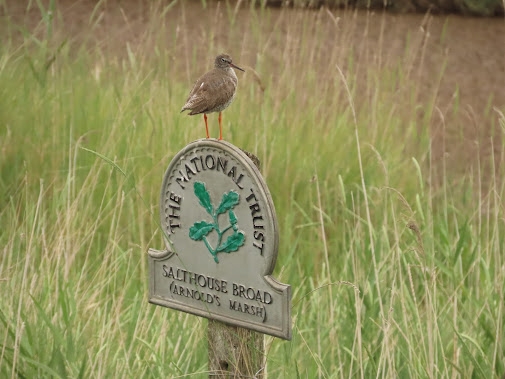Where would a holiday blog from Northumbria be without a post about the Farne Islands. Craggy islands that lie a few miles off the coast, the Farnes strut around the sea with their majestic cliffs, home to tens of thousands of breeding seabirds. However visiting late in the season, a lot of the seabird colonies had dispersed, and now only a few thousand birds were present, although all the PUFFINS were still around, a bird that's always a fan favourite with their multi coloured beaks.
With bird flu decimating a lot of seabird colonies along the coast, as if our birds aren't under a lot of pressure anyway, there were no landing parties on any of the islands. Boat trips were going ahead, but they were just out on the water sailing round without alighting. I took the usual Billy Shiels boat, and as luck would have it only seven or so people were on board, giving loads of room to walk about, and change position, handy when you need to take a photo. The boat left Seahouses harbour, where several broods of EIDER were out on the water, growing out of their little brown fluff stage, and headed out onto the water.
As with this July it was hot, but there was a nice breeze on the sea keeping temperatures low. Conditions on the water were calm as we headed towards the islands. I have been to the islands in June, the peak of the nesting time and usually you get an idea of what to expect as you get closer, the noise, the number of birds on the sea gradually increasing. But today in mid July, things were oddly quiet, no birds about, it was eerily quiet. And then they appeared, the first PUFFINS, small birds flying out of the way of the boat, and the strange people aboard watching them.
Everyone loves PUFFINS, they are one of those species that even non-birdwacthers love, just because they are so cute. I never liked the name "clowns of the sea", which they are sometimes called, because it doesn't do the species justice. Ok, so they look fairly comic in their movements, but there is a certain grace to their movements. They nest later in the season, so most of the birds were still present today, they disperse at the end of the month.
Less attractive than the puffins, GUILLEMOTS make up the numbers. With dark brown upperparts and a white underside they don't particularly stand out, but when there's fifty thousand of them they certainly make an impact. However today, in mid July most off the birds have nested and fledged young, and have left, so there were only the odd bird, late nesters, or those who have failed and started again. A few RAZORBILLS were around as well, different to guillemots, they have black upperparts, and that large distinctive bill. They nest on the cliffs, as do guillemots, but do so in much smaller numbers.
As puffins only nest on the top of the islands, and with no guillemots or razorbills about, the cliffs were eerily empty. However, despite the quietness of the abandoned islands, one sense was allowed to develop. The guano, the stains of white feaces that fall down the cliffs, signifying where birds had nested and pooed, gives off a very unique smell, one that's not unpleasant, but always gives that sense of being out among the seabirds. As a result I like the smell very much, a sign of being away from civilisation and its sterility.
On the Inner Farne, the largest and flattest island, ARCTIC TERNS were still nesting, with large numbers of birds wheeling through the air, with plenty of screeching from these freewheeling birds. It was a shame we couldn't alight as we used to do, because its hard to take photos of this graceful, yet fast flying and small bird. Also about were SHAGS, nesting on the cliffs, FULMARS, which fly with stiff unbent wings, and KITTWAKES, which are our true, sea gull.
After two hours on the water, we returned to Seahouses and dry land. These types of trip, out to the birds, are so enjoyable and such a great way to get away from it all. Birdwatching is such a great way to explore the world, to take you out to places that are really off the beaten track. And although a trip out to the Farnes isn't the most of adventurous of excursions, it is really a means to head out to the edges of civlisation.









































